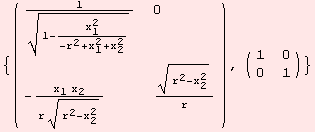Orthogonal frame via gram schmidt or eigendecomposition
Functions such as ![]() :
:![]() M→M require an orthonormal frame with respect to
M→M require an orthonormal frame with respect to ![]() . We use the eigenvectors of
. We use the eigenvectors of ![]() find a set of orthonormal vectors. We begin with a numerical treatment. The scalar product considered has index 1.
find a set of orthonormal vectors. We begin with a numerical treatment. The scalar product considered has index 1.
![]()

![]()
![]()
![]()
![]()

![[Graphics:../HTMLFiles/index_109.gif]](../HTMLFiles/index_109.gif)
An orthonormal vector is in the column of α.
![]()
![]()
![]()
![]()
![]()

The above procedure is carried out by
![]()

An alternative way to orthonormalize vectors is via gram schmidt. However, a basis of vectors of length ≠0 is required.
![]()

Even in low dimensions, expressions get quite lengthy when solving the problem algebraically. As an example, a metric for a coordinate environment for the sphere.
![]()
![]()
![]()
![]()
![]()

![]()

![]()

![]()
![]()
![]()

![]()
Just for fun, we plot f(![]() ,
,![]() ) with emphasis on real and imaginary part.
) with emphasis on real and imaginary part.
![]()
![]()
![]()
![[Graphics:../HTMLFiles/index_140.gif]](../HTMLFiles/index_140.gif)
![[Graphics:../HTMLFiles/index_141.gif]](../HTMLFiles/index_141.gif)
The two parts attached are
![]()
![]()
![[Graphics:../HTMLFiles/index_144.gif]](../HTMLFiles/index_144.gif)
![[Graphics:../HTMLFiles/index_145.gif]](../HTMLFiles/index_145.gif)
| Created by Mathematica (December 22, 2006) |